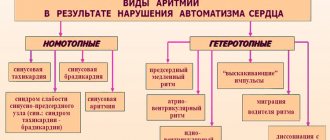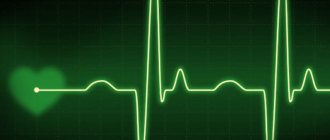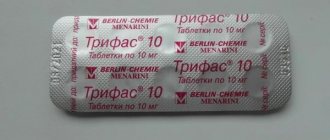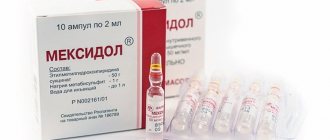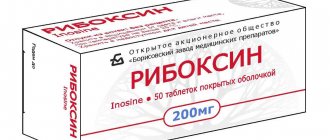Action in case of rhythm disturbance
The antiarrhythmic properties of Lidocaine manifest themselves mainly at the level of ventricular myocardial cells in the form of the following biological reactions:
- stabilizes the membrane;
- improves potassium penetration;
- accelerates recovery after the passage of an impulse;
- inhibits the process of excitation in Purkinje fibers;
- reduces the duration of the active period;
- stops the circular circulation of the signal.
The peculiarity of the mechanism of action of the drug is that it is most effective in relation to areas with impaired nutrition (ischemic), and has practically no effect on healthy heart tissue.
It should also be taken into account that the point of application for Lidocaine is the cells of the conduction system of the heart, which are located directly in the ventricles. For atrial arrhythmias, prescribing medication is not advisable.
In therapeutic doses, Lidocaine solution does not disrupt the conduction of impulses and the force of myocardial contraction. With rapid administration of large quantities of the drug, these adverse reactions may still occur, but for a short time. When entering a vein, the onset of action occurs “at the tip of the needle” - within one minute, and lasts about 20 minutes. Intramuscular injections normalize the rhythm in 5-10 minutes, their effect lasts up to 1.5 hours.
Cardiovascular drugs
Good afternoon, Oleg
Acetylsalicylic acid is taken not against the background of other drugs, but against the background of a specific disease. Judging by the medications you are taking, we are talking about hypertension or ischemic heart disease. (A combination of beta blockers and ACE inhibitors - GB, but low doses of ACE inhibitors - possibly coronary artery disease and ACE inhibitors were prescribed for the treatment of heart failure). In both the first and other cases, it is necessary to take acetylsalicylic acid in low doses, but while taking acetylsalicylic acid, when dyspeptic symptoms appear, it is necessary to take proton pump inhibitors (omeprazole, rabeprozole.....contraloc.....). But this issue must be resolved by your doctor.
Facial skin care with an electric toothbrush
information about the consultant
Indications for use
In cardiological practice, the drug is prescribed for the following ventricular arrhythmias:
For extrasystole, atrial fibrillation, and tachycardia, drugs of both new, modern and old generation are used. The current classification of antiarrhythmic drugs allows you to quickly make a choice from groups based on indications and contraindications
- A polarizing mixture has been used for a long time in cardiology. Indications are: the need to reduce the area of necrosis, improve the oxygen supply to the heart, and others. It is used in various variations, including with potassium and magnesium.
- Magnesium is prescribed for hypertension. Treatment is often carried out with IV drips. The course is selected by the doctor depending on the indicators and condition of the patients.
- The treatment method for ventricular tachycardia includes the use of drugs, electrical impulses, and in severe cases, the installation of a cardioverter-defibrillator. Relief of symptoms of paroxysmal VT affects the prognosis of the disease.
- You can take pills for heart palpitations only after consulting a cardiologist. The fact is that only he can choose which ones are needed to reduce the heart rate, since not all will help against a strong, rapid rhythm, tachycardia, arrhythmia.
Release form
Compound
Active ingredient: Lidocaine Concentration of active ingredient (%): 2%
Pharmacological effect
Class IB antiarrhythmic agent, local anesthetic, acetanilide derivative. Has membrane stabilizing activity. Causes a blockade of sodium channels in excitable membranes of neurons and membranes of cardiomyocytes. Reduces the duration of the action potential and the effective refractory period in Purkinje fibers, suppresses their automaticity. In this case, lidocaine suppresses the electrical activity of depolarized, arrhythmogenic areas, but has minimal effect on the electrical activity of normal tissues. When used in average therapeutic doses, it practically does not change myocardial contractility and does not slow down AV conduction. When used as an antiarrhythmic drug with intravenous administration, the onset of action is 45-90 seconds, duration is 10-20 minutes; with intramuscular injection, the onset of action is 5-15 minutes, duration - 60-90 minutes. Causes all types of local anesthesia: terminal, infiltration, conduction.
Pharmacokinetics
After intramuscular administration, absorption is almost complete. Distribution is rapid, Vd is about 1 l/kg (lower in patients with heart failure). Protein binding depends on the concentration of the active substance in plasma and is 60-80%. Metabolized mainly in the liver with the formation of active metabolites, which can contribute to the manifestation of therapeutic and toxic effects, especially after infusion for 24 hours or more. T1/2 tends to be biphasic with a distribution phase of 7-9 minutes. In general, T1/2 depends on the dose, is 1-2 hours and can increase to 3 hours or more during long-term IV infusions (more than 24 hours). Excreted by the kidneys in the form of metabolites, 10% unchanged.
Indications
A solution of lidocaine hydrochloride 2% is used for local anesthesia in ophthalmological, dental, surgical and otolaryngological practice. In addition, a 2% solution of lidocaine can be used to block peripheral nerves and nerve plexuses in patients with pain. A solution of lidocaine hydrochloride 10% is used for topical anesthesia mucous membranes in various fields of medicine (including gynecology, dentistry, gastroenterology, pulmonology, ENT practice) during diagnostic procedures and surgical interventions. A 10% solution of lidocaine hydrochloride is also used as an antiarrhythmic agent.
Contraindications
Lidocaine hydrochloride solution is not used for the treatment of patients with individual intolerance to the components of the drug, as well as other amide local anesthetic drugs (including a history of convulsions that developed in response to the administration of lidocaine hydrochloride). Lidocaine hydrochloride is contraindicated in patients suffering from atrioventricular block II and III degrees , heart failure of II and III degrees, sick sinus syndrome, Wolff-Parkinson-White syndrome and Adams-Stokes syndrome. It is not recommended to prescribe lidocaine to patients with severe bradycardia, arterial hypotension (systolic blood pressure less than 90 mm Hg), cardiogenic shock and complete transverse heart block. Do not use lidocaine hydrochloride solution for myasthenia gravis, porphyria, hypovolemia, as well as severe liver and kidney dysfunction. Pregnant and lactating women, as well as children under 12 years of age, the use of lidocaine hydrochloride is not recommended. Patients suffering from glaucoma, lidocaine hydrochloride solution is not administered retrobulbarly. It is recommended to be careful when prescribing lidocaine hydrochloride solution to patients with heart failure, incomplete atrioventricular block, epilepsy, arrhythmia (history). Only after a thorough study of the risk/benefit ratio is lidocaine used for cardiac surgery, and also prescribed to patients with a genetic tendency to hyperthermia and elderly patients. You should not drive a car or perform work that requires increased attention while using lidocaine hydrochloride solution.
Precautionary measures
Use during pregnancy and breastfeeding
During pregnancy and lactation, use only for health reasons. Lidocaine is excreted in breast milk. In obstetric practice, use paracervically with caution in cases of intrauterine development disorders, fetoplacental insufficiency, prematurity, postmaturity, and gestosis.
Directions for use and doses
Before using the drug Lidocaine hydrochloride, a skin test should be performed to identify possible hypersensitivity to the active component (in patients with hypersensitivity, when performing a skin test, the development of edema and hyperemia at the injection site is noted). When administering the solution intramuscularly, before starting to inject the drug into the muscle, the syringe piston should be slightly pulled back to avoid accidental intravascular injection of lidocaine. Lidocaine hydrochloride solution 2%: The drug is intended for intramuscular, subcutaneous administration, as well as for conduction anesthesia, instillation into the conjunctival sac and treatment of mucous membranes shells. The method of application and dose of lidocaine hydrochloride is determined by the attending physician individually. For local anesthesia, subcutaneous, intramuscular or local (for mucous membranes) application of lidocaine solution is usually prescribed. For conduction anesthesia, 100-200 mg of lidocaine hydrochloride is usually prescribed. For pain relief fingers, ear and nose, as a rule, 40-60 mg of lidocaine hydrochloride is prescribed. The maximum recommended daily dose of lidocaine for adults (with conduction anesthesia) is 200 mg. When injecting the solution, to increase the time of the therapeutic effect of lidocaine, the drug can be administered in combination with epinephrine (1 :50000-1:100000) in the absence of contraindications to the use of epinephrine in patients. In ophthalmic practice, 2 drops of lidocaine hydrochloride solution are usually prescribed into the conjunctival sac up to 3 times with an interval of 30-60 seconds. As a rule, 4-6 drops in one eye are enough for sufficient anesthesia during diagnostic procedures and surgical interventions. For terminal anesthesia, the mucous membranes are lubricated with 2-20 ml of lidocaine hydrochloride solution. The duration of terminal anesthesia is 15-30 minutes. The maximum daily dose of lidocaine hydrochloride solution for terminal anesthesia is 20 ml. For children with any type of peripheral anesthesia, the total dose of lidocaine should not exceed 3 mg/kg body weight. Lidocaine hydrochloride solution 10%: The drug is intended for intramuscular administration , as well as for topical anesthesia. The method of application and dose of lidocaine hydrochloride is determined by the attending physician individually. For topical anesthesia, the maximum recommended volume of a 10% lidocaine solution is 2 ml. If longer-term anesthesia is required, a lidocaine solution is used in combination with a 0.1% adrenaline hydrochloride solution (1 drop of adrenaline solution per 5-10 ml of lidocaine solution). To relieve an attack of arrhythmia, the drug is administered intramuscularly at a dose of 200-400 mg. If necessary, the administration is repeated after 3 hours. For arrhythmia, it is also possible to administer a 1% or 2% solution of lidocaine hydrochloride intravenously in a stream at a dose of 50-100 mg, after which they switch to intramuscular administration of a 10% solution of lidocaine hydrochloride according to the standard scheme. When using the drug Lidocaine hydrochloride 2% and Lidocaine hydrochloride 10% are recommended to monitor the ECG. Solutions containing heavy metals should not be used to disinfect the injection site. When using high doses of the drug, barbiturates are recommended before injection of lidocaine.
Side effects
Undesirable effects when using lidocaine solution are rare, but the development of such side effects cannot be excluded: From the sensory organs, central and peripheral nervous system: weakness, increased fatigue, headache, nystagmus, euphoria, drowsiness, photophobia, diplopia, hearing impairment, night nightmares, numbness of lips and tongue. In addition, the development of tremors of the limbs, convulsions, paresthesia, motor block, paralysis of the respiratory muscles and sensory disturbances is possible. From the heart and blood vessels: cardiac arrhythmias, decreased blood pressure, transverse heart block, cardiac conduction disorders, chest pain, peripheral vasodilation. In addition, mainly when using high doses of lidocaine, the development of collapse, heart block and cardiac arrest is possible. From the respiratory system: dyspnea, apnea, shortness of breath. Allergic reactions: skin itching, allergic rhinitis or conjunctivitis, exfoliative dermatitis, Quincke's edema, urticaria , anaphylactic shock. Others: vomiting, nausea, pain at the injection site, decreased body temperature, feeling of heat and numbness of the extremities, chills.
Overdose
There are no data on cases of overdose.
Interaction with other drugs
When used simultaneously with barbiturates (including phenobarbital), it is possible to increase the metabolism of lidocaine in the liver, reduce the concentration in the blood plasma and, as a result, reduce its therapeutic effectiveness. When used simultaneously with beta-blockers (including propranolol, nadolol) the effects of lidocaine (including toxic ones) may be enhanced, apparently due to a slowdown in its metabolism in the liver. When used simultaneously with MAO inhibitors, the local anesthetic effect of lidocaine may be enhanced. When used simultaneously with drugs that cause blockade of the nervous system muscle transmission (including with suxamethonium chloride), the effect of drugs that cause blockade of neuromuscular transmission may be enhanced. When used simultaneously with hypnotics and sedatives, the inhibitory effect on the central nervous system may be enhanced; with ajmaline, quinidine - possible increased cardiodepressive effect; with amiodarone - cases of the development of seizures and SSSU have been described. When used simultaneously with hexenal, sodium thiopental (iv), respiratory depression is possible. When used simultaneously with mexiletine, the toxicity of lidocaine increases; with midazolam - a moderate decrease in the concentration of lidocaine in the blood plasma; with morphine - enhances the analgesic effect of morphine. When used simultaneously with prenylamine, the risk of developing ventricular arrhythmia of the pirouette type develops. Cases of agitation and hallucinations are described when used simultaneously with procainamide. When used simultaneously with propafenone, the duration and severity of side effects from the central nervous system may increase. It is believed that under the influence of rifampicin, a decrease in the concentration of lidocaine in the blood plasma is possible. With simultaneous intravenous infusion of lidocaine and phenytoin, side effects of central origin may be increased; a case of sinoatrial blockade due to the additive cardiodepressive effect of lidocaine and phenytoin is described. In patients receiving phenytoin as an anticonvulsant, the concentration of lidocaine in the blood plasma may decrease, which is due to the induction of microsomal liver enzymes under the influence of phenytoin. When used simultaneously with cimetidine, the clearance of lidocaine and its concentration in the blood plasma increases, there is a risk of increased side effects of lidocaine.
special instructions
Caution should be used in conditions accompanied by a decrease in hepatic blood flow (including chronic heart failure, liver diseases), progressive cardiovascular failure (usually due to the development of heart block and shock), in severe and debilitated patients, in elderly patients age (over 65 years); for epidural anesthesia - for neurological diseases, septicemia, impossibility of puncture due to spinal deformity; for subarachnoid anesthesia - for back pain, brain infections, benign and malignant neoplasms of the brain, for coagulopathies of various origins, migraines, subarachnoid hemorrhage, arterial hypertension, arterial hypotension, paresthesia, psychosis, hysteria, in non-contact patients, the impossibility of performing a puncture from - for spinal deformities. Lidocaine solutions should be administered with caution into tissues with abundant vascularization (for example, in the neck area during operations on the thyroid gland); in such cases, lidocaine is used in smaller doses. When used simultaneously with beta-blockers, with cimetidine, a reduction is required lidocaine doses; with polymyxin B - respiratory function should be monitored. During treatment with MAO inhibitors, lidocaine should not be used parenterally. Injection solutions containing epinephrine and norepinephrine are not intended for intravenous administration. Lidocaine should not be added to blood transfusions. Impact on capacity to driving vehicles and operating machinery After using lidocaine, it is not recommended to engage in activities that require high concentration and rapid psychomotor reactions.
Instructions for use:
Lidocaine is a local anesthetic.
Drug treatment
This disease is a fairly common pathology. It ranked third on the list of reasons for hospitalization. Due to possible complications it is dangerous, especially for older people. Severe consequences can occur if you do not pay enough attention to such a serious manifestation as atrial fibrillation. Symptoms and treatment largely depend on the type of disease.
The following forms are distinguished:
- Recurrent. This diagnosis is made after several attacks.
- Paroxysmal. This form is characterized by spontaneous restoration of rhythm within a week.
- Persistent. If symptoms last more than one week, this form of the disease is diagnosed.
- Long-term persistent. This atrial fibrillation requires immediate hospitalization. Treatment is necessary for a very long time, usually about one year.
- Constant. It is diagnosed when there is a sufficiently long absence of normal sinus rhythm. Characterized by high duration.
The attack can end as suddenly as it began. Sometimes it goes away in a few minutes. But it happens that its duration is calculated in hours, and sometimes even days. If you feel an irregular heartbeat, you should definitely inform your doctor about this fact. If the attack lasts for several hours, you should urgently call for help from doctors.
Treatment methods for atrial fibrillation depend on the form of the disease. Tactics are aimed at restoring, followed by maintaining, sinus rhythm, preventing recurrence of attacks, strict control over the heart rate and preventing the formation of blood clots.
If a patient is diagnosed with paroxysmal atrial fibrillation, treatment includes the use of the following drugs:
- “Quinidine”;
- “Novocainamide”;
- “Cordaron”;
- “Propanorm.”
All medications are administered under the strict control of an electrocardiogram and blood pressure. These indicators make it possible to determine whether the choice of medications is effective, because atrial fibrillation occurs very individually. Drug treatment includes taking medications that help improve the well-being of patients. They are aimed at reducing shortness of breath and weakness. These are Anaprilin, Digoxin and Verapamil.
Atrial fibrillation that lasts more than two days can provoke the formation of blood clots. To avoid such a serious complication, doctors include the drug Warfarin in complex treatment.
If a chronic form of the disease is diagnosed, doctors recommend taking constantly prescribed adrenergic blockers. In this case, it is quite important to establish the cause of the attack. In those patients whose rhythm disturbance was provoked by the underlying disease, doctors begin therapy with it.
With repeated attacks, doctors consider more drastic methods. Treatment for permanent atrial fibrillation often involves implantation of a pacemaker.
Registered user
pharmachologic effect
Lidocaine is used for conduction, infiltration, and terminal anesthesia. The drug has a local anesthetic and antiarrhythmic effect.
As an anesthetic, the drug acts by inhibiting nerve conduction by blocking sodium channels in nerve fibers and endings. Lidocaine is significantly superior to procaine, its action occurs faster and lasts longer - up to 75 minutes (in combination with epinephrine - more than two hours). When applied topically, lidocaine dilates blood vessels and does not have a local irritating effect.
The antiarrhythmic effect of the drug is due to the ability to increase the permeability of membranes to potassium, block sodium channels, and stabilize cell membranes.
Lidocaine does not have a significant effect on myocardial contractility or conductivity (it affects only in large doses).
The level of absorption of Lidocaine when applied topically depends on the dosage of the product and the site of treatment (for example, Lidocaine is absorbed better on the mucous membranes than on the skin).
After intramuscular injections, Lidocaine reaches its maximum concentration 5-15 minutes after administration.
Side effects
Reviews are not indicative of the side effects of the drug Carvedilol. Patients are subjective in assessing clinical and side effects. Therefore, it is more rational to rely on statistical research. Among the side effects, the most common, occurring with a frequency of 1 to 10%, are the following:
- on the part of the PNS and central nervous system, the development of headaches, dizziness, muscle weakness, sleep disturbances, parasthesias as manifestations of idiosyncrasy is possible;
- cardiovascular effects (transient or permanent bradycardia or AV block, orthostatic hypotension, less commonly, claudication due to impaired blood supply to the muscles in obliterating atherosclerosis);
- respiratory organs: manifestations of shortness of breath, nasal congestion are possible, and in case of bronchial hyperreactivity or obstructive disease, bronchospasm is possible;
- side effects from the digestive system are manifested by abdominal pain, nausea, dry mouth, diarrhea, and extremely rarely constipation or vomiting occurs; liver transaminases may increase;
- the hematopoietic system extremely rarely reacts with thrombocytopenia or leukopenia;
- eczema, skin itching, exacerbation of psoriasis are possible, and anaphylactoid reactions can occur extremely rarely.
Also, since Carvedilol is a substance foreign to the body, a general toxic reaction may develop. It manifests itself as a flu-like syndrome with the development of pain in the extremities, dry eyes, and urinary irritation. In this regard, Carvedilol has many more side effects than Metoprolol, although the former is superior to the latter in clinical effectiveness.
Indications for use of Lidocaine
Lidocaine 2% injections are used for local anesthesia in dentistry, surgery, ophthalmology, otolaryngology, for blocking nerve plexuses, peripheral nerves in patients with pain.
Lidocaine in 10% ampoules is used for anesthesia in the form of mucosal applications in ENT practice, gynecology, pulmonology, gastroenterology, dentistry during operations and diagnostic procedures. A 10% solution is also used as an antiarrhythmic agent.
Lidocaine spray is used in dentistry for removing baby teeth, tartar, fixing dental crowns, and performing other manipulations that require short anesthesia; in otolaryngology - for tonsillectomy, truncation of nasal polyps, septum, pain relief for the process of piercing and washing the maxillary sinus.
Lidocaine spray is effective during diagnostic procedures (insertion of a gastroduodenal tube, replacement of a tracheotomy tube) for anesthesia of the pharynx.
In gynecology, the spray is used to remove sutures, cut the female perineum during childbirth, and perform operations on the cervix.
In dermatology, the spray is used to anesthetize mucous membranes and skin during minor surgical procedures.
Standard release forms
For the drug Carvedilol, price is not a determining criterion for choice. It is much more effective to choose the right dosage form for a particular patient. Most often, three types of medication dosages are distributed in the domestic and Western pharmacy chains. These are 25 mg, 12.5 and 6.25 mg. Tablets are packaged in blisters or polymer containers. Medicines are taken before meals, but if a reduction in dose activity is required, then during meals.
Contraindications
According to the instructions, lidocaine is contraindicated in cases of 2.3 degree atrioventricular block, 2.3 degree heart failure, severe bradycardia, arterial hypotension, cardiogenic shock, complete transverse heart block, porphyria, myasthenia gravis, severe renal and hepatic pathologies, hypovolemia, glaucoma (for eye injections ), hypersensitivity, lactation, pregnancy.
Lidocaine spray is prescribed with caution to weakened, elderly patients, children, patients with epilepsy, in states of shock, with bradycardia, pathology of liver function, conduction disorders, and pregnancy. During lactation, the spray can only be used in recommended dosages.
Generics
Generics are those drugs that contain Carvedilol in a specific dosage form that meets the requirements of bioequivalence in comparison with the original drug. And now on the domestic pharmacy market there are a lot of generics, divided into three categories according to their cost:
- with a high price (“Dilatrend”, “Coriol”, “Carvedilol Sandoz”);
- with an average price (“Carveland”, “Carvedilol Zentiva”, “Carvedilol Teva”);
- with a low price (“Karvedilol-MIK”, “Karvedilol Belmed”, “Karvetrend”, “Carvenal”, “Vedicardol”).
The cost of Dilatrend is 450-750 rubles, depending on the dosage: 6.25 mg is cheaper than 25 mg. A similar trend is naturally observed in the case of other drugs. The price for Coriol is 250-500 rubles, for Carvedilol Sandoz 300-550 rubles, for Carvedilol Zentiva - 250-400 rubles. "Karvedilol Teva" costs 200-300 rubles, "Karveland" - 170-330 rubles, "Karvedilol Belmed" - 150-250, "Karvetrend" - 170-290 rubles.
For the drug "Carvedilol" the price is not an indicator of quality, although it is higher for a medicine from a reputable manufacturer. In the clinic, there are few significant differences between expensive imported drugs and domestic, more affordable analogues. Often, clinicians are only concerned about the discrepancy between the dosage form and the original. Therefore, you should choose a generic capsule, which will significantly reduce its gastrotoxicity.
Otherwise, cheap analogues exhibit the same clinical activity and are effective for the treatment of heart diseases and arterial hypertension. However, if the patient has previously taken a certain generic drug, then it should be continued. Since he is accustomed to the peculiarities of the dosage form and the dynamics of the increase in plasma concentration of the active substance, replacing the drug will shift its balance. Then it will be subjectively noted that the medicinal substance does not work or does not work as desired.
Instructions for use of Lidocaine
Before using Lidocaine, according to the instructions, you should conduct an allergy test to identify possible sensitivity to the drug. If swelling or redness occurs, lidocaine should not be used for anesthesia.
A solution of 2% Lidocaine (in ampoules) is intended for subcutaneous, intramuscular administration, conduction anesthesia, instillation into the conjunctival sac, and treatment of mucous membranes.
The dosage of the drug is individual, but the instructions for Lidocaine indicate the following average dosages: for conduction anesthesia, use 100-200 mg of the drug (no more than 200 mg), for anesthesia of the nose, ears, fingers - 40-60 mg of the drug.
When prescribing lidocaine injections, epinephrine is additionally prescribed to achieve the maximum therapeutic effect (if there are no contraindications).
In ophthalmology, up to six drops of solution are dripped, instilling two drops every 30-60 seconds. Usually 4-6 drops. enough for one eye for pain relief before operations and diagnostic procedures.
For terminal anesthesia, the maximum permissible dose of lidocaine according to the instructions is 20 ml. Treatment duration is 15-30 minutes.
When administering anesthesia to children, the total dosage should not exceed 3 mg per kg of child weight.
A solution of 10% Lidocaine (in ampoules) is administered intramuscularly and used in the form of applications. The permissible volume of Lidocaine for applications is 2 ml.
To stop an arrhythmic attack, an intramuscular injection of Lidocaine is given - 200-400 mg. If the attack is not stopped, a second injection is given three hours later.
In case of arrhythmia, a 1.2% solution can be administered intravenously in a bolus - 50-100 mg, after which, according to the instructions, lidocaine is administered intramuscularly.
When using Lidocaine in ampoules of 2 and 10%, you should monitor the ECG and refrain from disinfecting the injection site with solutions containing heavy metals.
When prescribing the drug in high doses, barbiturates are taken before the injection.
Lidocaine spray is used only topically. Spray the drug from a short distance directly onto the area requiring pain relief, avoiding contact with the eyes and respiratory tract.
When irrigating the oral cavity, due to decreased sensitivity, care should be taken not to injure the tongue with the teeth.
In dentistry and dermatology, 1-3 doses of 10% Lidocaine are used; in otolaryngology, craniofacial surgery – 1-4 doses of 10% Lidocaine; for endoscopic examination - 2-3 doses of 10% solution; in gynecology - 4-5 doses (while in obstetric practice, the use of up to 20 doses of a 10% solution is allowed).
When treating large areas, you can use a swab irrigated with lidocaine from a can.
Surgical intervention
Initially, doctors try to stabilize the patient’s condition with medications. If no positive results are found, doctors consider more serious treatment for atrial fibrillation. Surgery becomes the only chance to overcome the disease. Today, there are several types of surgical interventions.
- Catheter ablation. This method is considered low-traumatic because it does not require large incisions. As a rule, persistent atrial fibrillation leads to surgical intervention. Treatment begins with research. And only after identifying the areas that provoke rhythm disturbances, the doctor destroys the cells that cause the atria to flicker. The operation is performed under local anesthesia. As a rule, intervention occurs through the subclavian vein.
- Pacemaker implantation. In some cases, surgical treatment of atrial fibrillation involves installing a special medical device. This is the only way to restore the normal rhythm of heart contractions. The functions of a pacemaker can be to contract only the atrium or in combination with the ventricles. Most modern devices are very easily adaptable to all human needs. So, when the patient is active, the device can speed up the rhythm to provide the necessary blood flow to the muscles and lungs.
Of course, a pacemaker brings many benefits. It will not only improve your condition, but also allow you to become more resilient. It is important not to forget that the body constantly wears a complex device. Some restrictions are imposed on a person with such a rhythm stimulator.
We will have to accept prohibitions on:
- MRI (only CT is allowed);
- Ultrasound in the area of the pacemaker;
- physiotherapy;
- exposure to electric current on the body (cosmetic procedures, surgeries, everyday life).
You should definitely listen to your well-being and not overload yourself with excessive stress. Do not forget that atrial fibrillation requires mandatory prevention. Treatment with folk remedies (as an additive to the main therapy) will help support the body. Many recipes invented by our ancestors will protect against new attacks.
Diagnostics
The doctor makes the final diagnosis after a comprehensive examination.
For this we use:
- Measuring the pulse rate will allow you to get an initial impression of the patient’s condition and confirm the presence of arrhythmia. The flickering work of the heart muscle is noticeable to an experienced doctor by two signs: increased heart rate and periods when it is impossible to listen to the pulse at all.
- Electrocardiogram Electrocardiogram - it allows you to determine the frequency and intensity of flicker, the duration of pauses in the heart. The sparkling rhythm on the cardiogram has a small amplitude and frequent “teeth”. There are also intervals of varying lengths between peaks of activity.
- Daily electrocardiographic monitoring makes it possible to determine the frequency and nature of attacks, in which part they occur and how dangerous they are for the patient’s condition.
- Ultrasound of the heart allows you to evaluate the thickness of the heart walls, the presence of thickened or weak and thin areas, blood clots, the presence of tumors, aneurysms, and changes in the structure of the aorta.
- MRI of the heart gives the most complete picture of the condition and functioning of the organ, allows you to determine the presence of congenital and acquired pathologies, the degree and nature of changes that have affected the heart muscle.
- Exercise tests help determine your heart's endurance, how you perform at peak capacity, and the required recovery period.
Read also: Episodes of sinus arrhythmia
The doctor may also prescribe additional research methods - ultrasound of the thyroid gland: disturbances in its functioning and hormonal imbalances often provoke attacks of atrial fibrillation.
Drug interactions
Carvedilol interacts with some medications. You should pay attention to the combination of antihypertensive medication with such drugs as:
- Digoxin. When taken simultaneously with it, there is a high risk of increasing the dose of digoxin in the blood and causing bradycardia. AV conduction may also be impaired.
- Insulin, hypoglycemic agents. When combined with them, the patient may develop hypoglycemia.
- Clonidine. Together with it, Carvedilol can cause severe bradycardia, an excessive decrease in blood pressure, and conduction failure.
- Reserpine, MAO inhibitors. If combined with these drugs, severe hypotension and bradycardia may develop.
When prescribing an antihypertensive drug, the attending physician must take into account these interactions.
Carvedilol tends to react chemically with other medications
Types of atrial fibrillation and their characteristics
Vagal type MA
- This type of disease almost always affects only men; only 10% of cases are reported in female patients.
- Most often, atrial fibrillation of the vagal type is observed from 6 pm to 5-7 am, as well as after heavy meals, especially with large amounts of fatty foods.
- In addition, such insignificant factors, in the opinion of many, as a tight collar, belt, increased gas formation, lying down for a long time, can cause a vagal attack, so it is better to sleep on a slight elevation, being at rest for more than 3-5 hours.
- Atrial fibrillation of this type is not provoked by changes in mood and when under stress and due to emotional upsurge.
Vagal and hyperadrenergic forms of atrial fibrillation
Hyperadrenergic MA
- Unlike the first type of MA, only 10% of male patients suffer from this type of pathology.
- Most attacks occur between 7 a.m. and 2 p.m.; in exceptional cases, the condition may worsen during the day and evening.
- An increase in heart rate occurs due to severe emotional shock, depression and nervous experience.
- In the first stages of atrial fibrillation therapy of the hyperadrenergic type, attacks are stopped after taking a horizontal position, calming down and avoiding any physical and emotional stress.
Attention. It is important to know all the manifestations and symptoms of atrial fibrillation therapy, as this will avoid possible death due to late provision of the required medical care.


